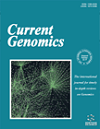- Home
- A-Z Publications
- Current Genomics
- Previous Issues
- Volume 2, Issue 3, 2001
Current Genomics - Volume 2, Issue 3, 2001
Volume 2, Issue 3, 2001
-
-
The Hereditary Disease Array Group (HDAG) - Microarrays, Models and Mechanisms : A Collaboration Update
More LessAuthors: T. Kiehl, J.M. Olson and S.M. PulstA growing number of dominantly inherited neurodegenerative disorders are associated with an expanded polyglutamine-encoding sequence. Alterations in gene expression have been described for several of these diseases. Many animal and cell culture models have been established. In order to generate gene expression profiles of model systems using microarray technology, the Hereditary Disease Array Group (HDAG) Read More
-
-
-
The Human SIX Family of Homeobox Genes
More LessAuthors: S. Cordoba, M. Gallardo, J. Rios and P. BovolentaThe Drosophila sine oculis (so) gene is a high hierarchy and essential gene in the developmental pathway of the fly visual system. so is the founder member of the SIX family, which in the fly also includes the genes D-six3 (optix) and D-six4 and in vertebrates, the SIX1, SIX2, SIX3, SIX4, SIX5 and SIX6 genes. In addition to a homeobox domain, all members of the SIX family of proteins contain a characteristic highly conserved regio Read More
-
-
-
Protein Coding Gene Sequences: Alternative Phylogenetic Markers or Possible Tools to Compare Ecological Diversity in Bacteria?
More LessBy G. GiraffaDNA sequences of protein-coding genes seem to be more effective than 16S rRNA gene sequencing for classifying the ecological diversity of bacteria. This fact, however, may be a consequence of the low evolutionary rate of 16S rRNA genes. While 16S rRNA gene sequence data are useful for placing moderately divergent populations into separate sequence clusters, protein-coding genes provide a more effective tool Read More
-
-
-
Genomic Analysis of GPR37 and Related Orphan G-Protein Coupled Receptor Genes Highly Expressed in the Mammalian Brain
More LessAuthors: D. Marazziti, E. Golini, A. Magrelli, R. Matteoni and G.P. Tocchini-ValentiniG-protein coupled receptors (GPCRs) constitute the largest set of cell membrane proteins involved in signal transduction and more than half of all drugs currently available influence their activity. Furthermore, genomic sequencing techniques have already enabled the isolation of more than hundred genes that encode so called orphan receptors representing a fruitful resource of potential targets for cellular signaling studies Read More
-
-
-
Fusogenic Viral Envelopes as Potent Vehicles for Gene Transfer
More LessAuthors: E.G. Ponimaskin and M.f.g. SchmidtThe development of methods for efficiently introducing foreign genes into living cells provides novel tools to investigate intracellular processes at the molecular level. In addition, the development of suitable delivery vehicles for in vivo gene transfer is a prerequisite for clinical application of therapeutic genes. This review will summarize the current status of the development of both viral as well as non-viral vectors for gene t Read More
-
-
-
Reverse Genetics in Plants
More LessAuthors: A. Tisser and P. BourgeoisComplete genomic sequences of several plant species, most notably the models Arabidopsis thaliana and rice, is now available. One way to discover the biological role of the thousands of new genes is reverse genetics. Plant molecular biologists have already developed several reverse genetics tools. The purpose of this review is to explore the technological avenues taken to address this question and to provide an updat Read More
-
-
-
Improvement of Livestock Breeding Strategies Using Physiologic and Functional Genomic Information of the Muscle Regulatory Factors Gene Family for Skeletal Muscle Development
More LessAuthors: M.F.W. Te Pas and A. SoumillionA defined number of skeletal muscle fibers are formed in two separate waves during prenatal development, while postnatal growth is restricted to hypertrophic muscle fiber growth. The genes of the MRF (muscle regulatory factors) gene family, consisting of 4 structurally related transcription factors - myogenin, MyoD1, myf-5, and MRF4 - regulate both skeletal muscle fiber development and postnatal hypertrophic growth. In m Read More
-
Volumes & issues
-
Volume 26 (2025)
-
Volume 25 (2024)
-
Volume 24 (2023)
-
Volume 23 (2022)
-
Volume 22 (2021)
-
Volume 21 (2020)
-
Volume 20 (2019)
-
Volume 19 (2018)
-
Volume 18 (2017)
-
Volume 17 (2016)
-
Volume 16 (2015)
-
Volume 15 (2014)
-
Volume 14 (2013)
-
Volume 13 (2012)
-
Volume 12 (2011)
-
Volume 11 (2010)
-
Volume 10 (2009)
-
Volume 9 (2008)
-
Volume 8 (2007)
-
Volume 7 (2006)
-
Volume 6 (2005)
-
Volume 5 (2004)
-
Volume 4 (2003)
-
Volume 3 (2002)
-
Volume 2 (2001)
-
Volume 1 (2000)
Most Read This Month
Article
content/journals/cg
Journal
10
5
false
en


